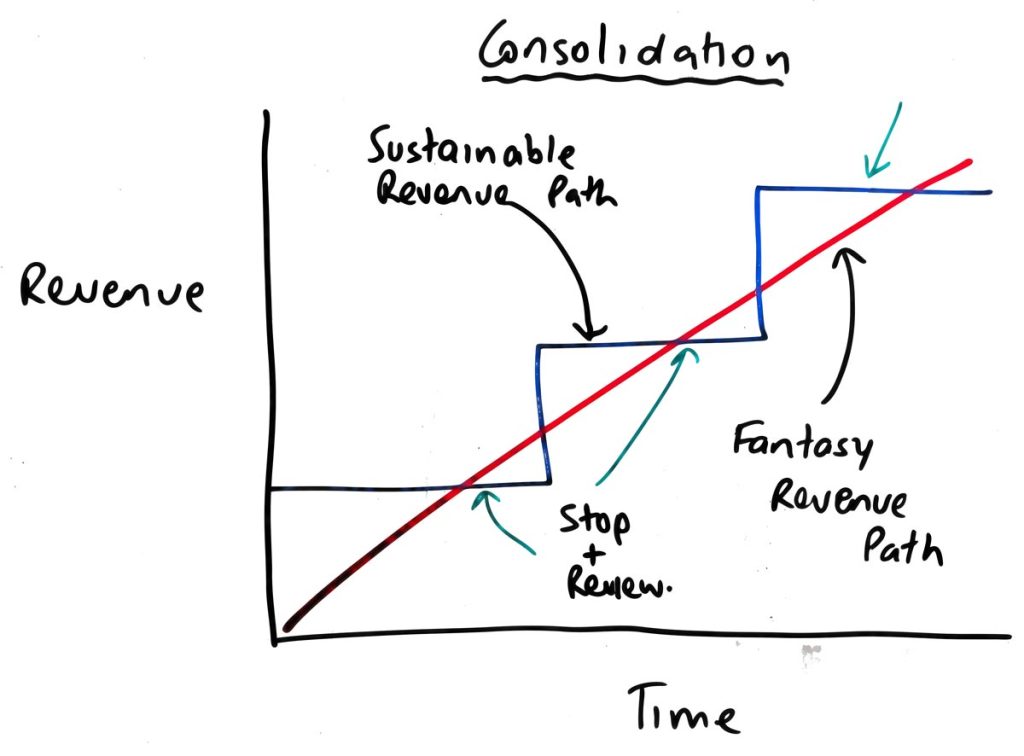Edition 383 – Consolidation
Most business owners have this dream of their business taking off like a rocket ship. From idea to riches in no time at all is how people like to think it will evolve. The reality, of course, is significantly different, and for good reason.
In the work that I undertake with my small and family business clients, we often talk of the need to consolidate our position – to stop and take stock. The following is a graphic that I draw for my clients in most meetings.

You cannot successfully grow your business in a permanent upward trajectory. Even if you can, you shouldn’t for, eventually, you’ll crash back to earth faster than you were headed for space.
It all depends on the business, however there are usually revenue markers that come into play when consolidating your position in the business. It’s my experience that for most small businesses, those markers are:
- $1m
- $3m
- $5m
- $10m
At each of those points, your business will morph into a new beast. So, for instance, beyond $1m, it’s pretty difficult to do everything with just you, your life partner and one or two other staff. You need to start to bring in additional people to help service your clientele, which means you need to ask yourself a whole series of other questions, such as:
- Do we have the right staff on board, now?
- Are they trained at the right level?
- Do we have the right level of funding?
- Do we need additional vehicles and equipment.
- Do we need to move to bigger premises (or sometimes, out of the garage, actually into premises)?
- Should our IT be beefed up?
- What clients are we servicing now and who do we want to appeal to in the future?
Too many small and family businesses don’t stop and take stock. The business owners are so busy being busy that they’re chasing the next opportunity without looking after their most important client – their own business! Invariably, what happens when businesses don’t stop to review and consolidate their position is:
- Revenues tend to stagnate.
- Profits drop away.
- Frustration levels increase – amongst clients, owners and staff.
- Innovation dies.
It’s why many businesses fail to realise their full potential, why business owners get bored in their business and, eventually, proof that some business owners have built themselves a job, not a business.
In my experience, this period of consolidation can take anywhere from three months to two years. When I mentioned that to a client recently, their response was “but I feel like we’ve spent the past year consolidating”. In their situation, that is definitely the case. However, they were struggling with a senior team member who simply wasn’t cutting the mustard in terms of their ability to lead a crew of people, in spite of the time and financial investment of the owners. My guess – when they move that person on, they will elevate someone else into the team leader role, which will then give the business the management capacity to make the next leap in revenue. If you try to grow without the right resources in the right spots, you won’t grow – you’ll crash.
Consolidation is an interesting business phenomenon for small and family business owners to get their head around. They’re impatient to make their mark in life, through their business. Yet, without slowing down the growth trajectory, reviewing where they’re at, and where they’re headed, their business may not be around to celebrate those key milestones in the future.
This Week’s Tip
Unless you invest in consciously reviewing each stage of your business’ development, you’ll hinder the growth of your business.